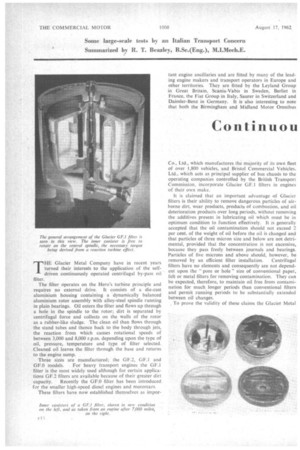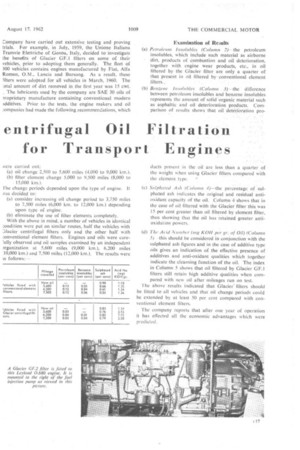Continuou entrifugal Oil Filtration for Transport Engines
Page 46

Page 47

If you've noticed an error in this article please click here to report it so we can fix it.
THE Glacier Metal Company have in recent years turned their interests to the application of the selfdriven continuously operated centrifugal by-pass oil filter.
The filter operates on the Hero's turbine principle and requires no external drive. It consists of a die-cast aluminium housing containing a dynamically balanced aluminium rotor assembly with alloy-steel spindle running in plain bearings. Oil enters the filter and flows up through a hole in the spindle to the rotor; dirt is separated by centrifugal force and collects on the walls of the rotor as a rubber-like sludge. The clean oil then flows through the stand tubes and thence back to the body through jets, the reaction from which causes rotational speeds of between 3,000 and 8,000 r.p.m. depending upon the type of oil, pressure, temperature and type of filter selected. Cleaned oil leaves the filter through the base and returns to the engine sump.
Three sizes are manufactured; the GF.2, GF.1 and GF.0 models. For heavy transport engines the GF.1 filter is the most widely used although for certain applications GF.2 filters are available because of their greater dirt capacity. Recently the GEO filter has been introduced. for the smaller high-speed diesel engines and motorcars. These filters have now established themselves as impor tacit engine ancillaries and are fitted by many of the leading engine makers and transport operators in Europe and other territories. They are fitted by the Leyland Group in Great Britain, Scania-Vabis in Sweden, Berliet in France, the Fiat Group in Italy, Saurer in Switzerland and Daimler-Benz in Germany. It is also interesting to note that both the Birmingham and Midland Motor Omnibus
Co., Ltd., which manufactures the majority of its own fleet of over 1,800 vehicles, and Bristol Commercial Vehicles. Ltd., which acts as principal supplier of bus chassis to the operating companies controlled by the British Transport Commission, incorporate Glacier GF.I filters in engines of their own make.
It is claimed that an important advantage of Glacier filters is their ability to remove dangerous particles of airborne dirt, wear products, products of combustion, arid oil deterioration products over long periods, without removing the additives present in lubricating oil which must be in optimum condition to function effectively. It is generally accepted that the oil contamination should not exceed 2 per cent. of the weight of oil before the oil is changed and that particles of three micron size and below are not detrimental, provided that the concentration is not excessive, because they pass freely between journals and bearings. Particles of five microns and above should, however, be removed by an efficient filter installation. Centrifugal filters have no elements and consequently are not dependent upon the "pore or hole" size of conventional paper, felt or metal filters for removing contamination. They can be expected, therefore, to maintain oil free from contamination for much longer periods than conventional filters and permit running periods to be substantially extended between oil changes.
To prove the validity of these claims the Glacier Metal Company have carried out extensive testing and proving trials. For example, in July, 1959, the Unione Italians Tramvie Elettriche of Genoa, Italy, decided to investigate the benefits of Glacier GF.1 filters on some of their vehicles, prior to adopting them generally. The fleet of 300 vehicles contains engines manufactured by Fiat, Alfa Romeo, 0.M., Lancia and Bursung. As a result, these Filters were adopted for all vehicles in March, 1960. The lotal amount of dirt removed in the first year was 15 cwt. , The lubricants used by the company are SAE 30 oils of iroprietary manufacture containing conventional modern idditives. Prior to the tests, the engine makers and oil :ompanies had made the following recommendations, which .vere carried out; (a) oil change 2,500 to 5,600 miles (4,000 to 9,000 km.).
(b) filter element change 5.000 to 9,500 miles (8.000 to • 15,000 km.).
[he change periods depended upon the type of engine. It was decided to: (a) consider increasing oil change period to 3,750 miles to 7,500 miles (6,000 km. to 12,00tl km.) depending upon type of engine.
(b) eliminate the use of filter elements completely.
With the above in mind, a number of vehicles in identical condition were put on similar routes, half the vehicles with Zilacier centrifugal filters only and the other half with conventional element filters. Engines and oils were careFully observed and oil samples examined by an independent )rganization at 5,600 miles (9,000 km.), 6,200 miles 10,000 km.) and 7,500 miles (12,000 km.). The results were is follows:—
Examination of Results (a) Petroleum Ins°bibles (Column 2)---the petroleum insolubles, which include such material as airborne dirt, products of combustion and oil deterioration, together with engine wear products, etc., in oil filtered by the Glacier filter are only a quarter of that present in oil filtered by • conventional element filters..
(b) Benzene Insolubles (Column . 3)--the difference between petroleum insolubles and benzene insolubles represents the amount of solid organic material such as asphaltic and oil deterioration prodiacts. Com-parison of results shows that oil deterioration pro ducts present in the oil are less, than a Cluarter, of the weight when using Glacier filters compared with the element type.
(e) Sul pirated Ash (Column 4)—the percentage of sulphated ash indicates the original and residual antioxidant capacity of the oil. Column 4 shows that in the case of oil filtered with the Glacier' filter this was 15 per cent greater than oil filtered by element filter, thus showing that the oil has retained greater antioxidat ion powers.
(d) The Add Number (mg KOH per gr. of Oil)(Column 5) this should be considered in conjunction with the sulphated ash figures and in the case of additive type oils gives an indication of the effective presence of additives and anti-oxidant qualities which together indicate the cleansing function of the oil. The index in Column 5 shows that oil filtered by Glacier GF.1 filters still retain high additive qualities when compared with new oil after mileages run on test.
The above results indicated that Glacier' filters should be fitted to all vehicles and that oil change periods could be extended by at least 50 per cent compared with conventional element filters.
The company reports that after one year of operation it has effected all the economic advantages which were predicted.












































































































